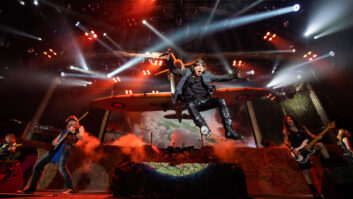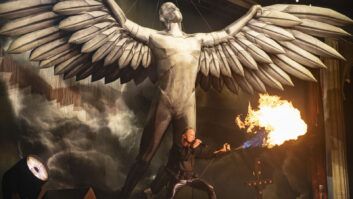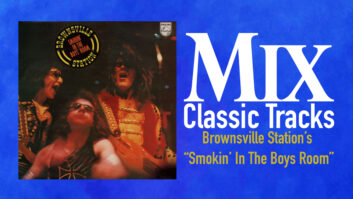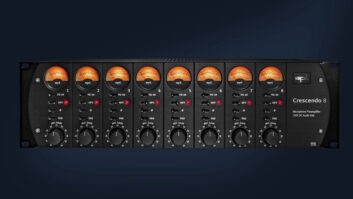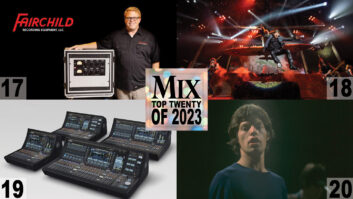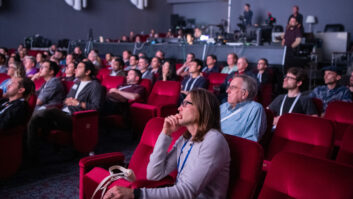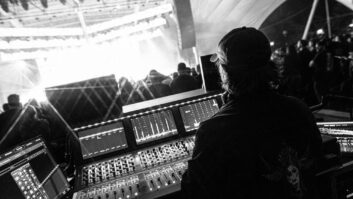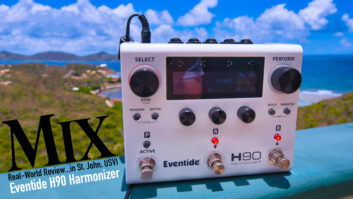
Now in their 44th year since being founded by dynamic bassist Steve Harris and approaching the 40th anniversary of the release of their debut, self-titled album, Iron Maiden seems virtually timeless. They continue to sell out arenas and stadiums all over the world, and on their current U.S. tour sound as strong from the opening notes of “Aces High” to the closing wail of “Run to the Hills.”
Currently mixing at front of house is Ken “Pooch” Van Druten, who has been with the group for two years. Like many engineers, Pooch got his start in high school playing in bands, though his high school bands were more on the jazz front. He went to Berklee College of Music on scholarship for bass, and that’s when he transitioned to engineering. His résumé is quite diverse and includes rapper Jaz-Z, Eminem, Whitney Houston, Justin Bieber, and what he calls “legacy” bands like Kiss and Guns N’ Roses.
Van Druten has been using a DiGiCo SD7 Quantum with Waves plugins at FOH for Iron Maiden. His plug-ins include the C6, PSE, De-Esser, Vocal Rider Live, CLA-76, H-Reverb, Doubler, SSL Channel, DBX-160, Saphira, RVerb, SSL Comp, API2500, Renaissance Axx, HDelay and F6. He also uses some outboard gear, including a Rupert Neve Designs Master Buss Processor.
“It’s a piece of analog gear that I really like,” Van Druten explains. “It’s a compressor and a limiter, but it also has a feature that spreads frequency stuff around. You can actually take the midrange and kind of spread it out, or take the low-end part of your mix and push it forward. It’s a great unit.”
Iron Maiden does have a few prerecorded audio bits before songs like “Where Eagles Dare” and “The Number of the Beast.” Aside from the Winston Churchill speech excerpt at the start of show opener, “Aces High,” Van Druten is triggering all the sounds from a Maschine MK2. He also uses triggers on the drums to open gates.

“What we’re doing is using the triggers to open the gate threshold of the toms, so it really makes the gate super-tight as opposed to just using the analog audio signal to open the threshold,” he explains.
Another interesting aspect of mixing Iron Maiden is the simple fact that there are three guitar players.
“Honestly, the biggest challenge I face with Iron Maiden is that all three guitar players play similar-sounding guitars,” Van Druten says. “They have very similar tones, and they all need to be defined. People who see Iron Maiden are Janick [Gers] fans, and fans that are Adrian [Smith] fans, and Dave [Murray] fans. Everybody that comes to the show wants to be able to hear each individual guitar player. I mostly mix that by creating pockets of space for them in the left and the right. I place them as they are on stage. Creating EQ and panning space for each individual guy to give them their own space is what I do.
“It’s also difficult because Steve Harris’ bass tone doesn’t have a lot of low end in it, and it has a lot of the same frequencies, so for the most part, there’s four guitar players,” he continues. “Obviously, his tone is important and should be forward in the mix. If you listen to any of the records, you know his tone is upfront. It’s not your typical rock band where you just throw up drums and throw some guitars in there and then a vocal over the top. It’s a difficult band to mix.”
On the current tour, Maiden partnered with Clair Global and are flying a Cohesion system with CO-12s on the main hang and CO-10s on the sides. “It’s a really great P.A. with 12-inch drivers, so it lends to a band that has three guitar players in it,” Van Druten explains.
System engineer Mike Hackman, who has been with Iron Maiden for more than a decade, plays a key role in getting the P.A. to sound its best, according to Van Druten, who defers to Hackman to set the P.A. each night while concentrating on the mix.
Iron Maiden still mostly has an old-school approach to amplification. All three guitarists, plus Harris, have amps and cabinets on stage, and Van Druten says he depends far more on miking the cabinets than on using DIs, though he does have those in the loop, as well.
“We use Palmer PDI 09 speaker DIs on all three guitar players, but the main tones that I use are the mics in front of the guitar amps,” he explains. “For instance, for Dave Murray, who has a traditional loud guitar tone, the Shure SM57 sounds the best in front of it, so I lean hard on the SM57 and have a speaker DI underneath to add some more clarity and definition. As far as the other guys go, its similar. We’re using a couple of different manufacturers’ microphones up there, but a quite a few Shure up front as well. It’s really a traditional loud stage.
“We are miking the bass cabinet, too, and that is also what we lean on hard. It’s a Shure SM7B, which is a great large-diaphragm microphone for bass guitar. The DI alone doesn’t get the sound that everyone knows as Steve Harris, so we mike his cabinet.”
Though Iron Maiden has experimented with other microphones, Van Druten still feels the tried and trusted Shure SM58 is the best for vocals, especially for Bruce Dickinson. “It’s one of those microphones that everyone tries to replicate and make better, and they can’t,” he laughs. “As soon as you put an SM58 in front of Bruce, it just sounds really good.”
The drum kit is miked with a greater variety of microphones than the other instruments, according to Van Druten.
“We have a Shure Beta 91A and a Beta 52A in the kick drum. They are totally enclosed in the kick drum, there’s no hole in the front. There’s a Randy May rail system there for both microphones that we use to adjust the distance between the inside of the kick drum, and those two microphones work very well together. The snare drum is an SM57 on the bottom and Telefunken M81 on top. Hi-hat is a DPA 2011. All the toms are DPA 4099s. The overheads and the cymbal are Mojave MA-201 FETs.”
Working monitors is Kevin “Tater” McCarthy, who previously worked with Van Druten on the Linkin Park tour. McCarthy’s résumé includes Slash, Stone Temple Pilots and Judas Priest. He, too, is mixing on a DiGiCo SD7 Quantum with Waves plug-ins.
“I really only use three—a C6, an L2 and an SSL G-Master Buss Compressor—and I only use them on the in-ear mixes,” he says. “I also use Klang. I have two units. Everything I have is redundant in case I have to switch engines. I have double the Waves, double the Klang, and that’s about all I use. All the effects I use are onboard DiGiCo.”
All three guitarists have Shure PSM 1000 in-ear setups. Smith and Gers are using JH Audio Roxanne customs, while Murray recently switched to the JH Audio Lola. Drummer Nicko McBrain, as well as Dickenson and Harris, eschew ears, favoring Turbosound TMS-3 wedges. The three guitarists have the TMS-3, as well, to supplement their ear mixes.
“The one little tricky thing with them is all three of them like a nontraditional ear mix,” explains McCarthy. “They like what it would sound like on stage if they didn’t have ears, just quieter. I use the Klang to help me place those instruments. They like to hear the guitars from behind themselves, not really left and right in the ear mix. The Klang helps me really make it feel like those sounds are behind them; like the guitar, their backline is behind them just like it is on stage.
“Now, Bruce, I have a lot of different kind of wedges for him all over the stage and side fills,” McCarthy continues. “I don’t mix Steve. Steve has his own monitor mixer, Steve Smith, ‘Gonzo’ we call him, and he’s on a DiGiCo SD12, and he mixes Steve’s wedges and Steve’s side fills.”
In talking with Pooch and McCarthy, it’s clear both love being on the road with Iron Maiden. Says Pooch: “I’ve mixed a bunch of other acts, including acts that are hot right now, and they don’t have any experience before last year. Working for a band that’s been around 44 years is an absolute pleasure. They understand what it takes to put on a rock show, and they treat their crew with respect in regard to that. I will work here as long as they will have me.”
